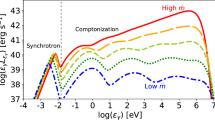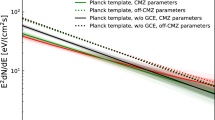Abstract
ACCORDING to the results of extensive air shower experiments, as inferred from observed electron densities, the integral energy spectrum of cosmic particle radiation  , where f is the combined distribution function of energy E, atomic number A and direction Ω, is of the form s−γ, with γ≅1.6 for E<∼1016 eV, γ≅1.8 for ∼1016 eV <E < ∼ 1018 eV and γ≅l.6 for E>∼1018 eV. There is still some uncertainty about the exact position of the first knee and about the existence of the second one. If they really exist, they may be consequences of the transition from galactic to extragalactic contributions caused by the presence of a large scale ordered magnetic field in the galactic disk. The chemical composition of cosmic particle radiation, ∫dΩ f(E,A,Ω), which is well known in the low energy range, has also been the object of intensive, though still inconclusive, investigations in the high energy region E> ∼1014 eV, by the measurement of the muon content1 or from the core structure of extensive air showers2 in connexion with Monte Carlo simulations of cascade development3. The amplitude of possible anisotropic contributions to the angular distribution
, where f is the combined distribution function of energy E, atomic number A and direction Ω, is of the form s−γ, with γ≅1.6 for E<∼1016 eV, γ≅1.8 for ∼1016 eV <E < ∼ 1018 eV and γ≅l.6 for E>∼1018 eV. There is still some uncertainty about the exact position of the first knee and about the existence of the second one. If they really exist, they may be consequences of the transition from galactic to extragalactic contributions caused by the presence of a large scale ordered magnetic field in the galactic disk. The chemical composition of cosmic particle radiation, ∫dΩ f(E,A,Ω), which is well known in the low energy range, has also been the object of intensive, though still inconclusive, investigations in the high energy region E> ∼1014 eV, by the measurement of the muon content1 or from the core structure of extensive air showers2 in connexion with Monte Carlo simulations of cascade development3. The amplitude of possible anisotropic contributions to the angular distribution  has been found to be within the limits of statistical error, which are typically of the order of 0.1 per cent for E<∼1016 eV (refs. 4 and 5), of the order of 1 per cent for ∼1016 eV <E< ∼1018 eV (ref. 6) and of the order of 10 per cent for E> ∼1018 eV. When studying the magnetic cut-off, the combined distribution function f′(ρ,Ω) of magnetic rigidity ρ= E/Ze and direction Ω may be considered instead of f(E,A,Ω), where Z is the charge number corresponding to A.
has been found to be within the limits of statistical error, which are typically of the order of 0.1 per cent for E<∼1016 eV (refs. 4 and 5), of the order of 1 per cent for ∼1016 eV <E< ∼1018 eV (ref. 6) and of the order of 10 per cent for E> ∼1018 eV. When studying the magnetic cut-off, the combined distribution function f′(ρ,Ω) of magnetic rigidity ρ= E/Ze and direction Ω may be considered instead of f(E,A,Ω), where Z is the charge number corresponding to A.
This is a preview of subscription content, access via your institution
Access options
Subscribe to this journal
Receive 51 print issues and online access
$199.00 per year
only $3.90 per issue
Buy this article
- Purchase on Springer Link
- Instant access to full article PDF
Prices may be subject to local taxes which are calculated during checkout
Similar content being viewed by others
References
Fukui, S., Hasegava, H., Matano, T., Miura, I., Oda, M., Suga, K., Tanahashi, T., and Tanaka, Y., Prog. Theor. Phys. Suppl., 16, 1 (1960).
Winn, M. M., Wand, R. H., Ulrichs, J., Rathgeber, M. H., Poole, P. C., Nelson, D., McCusker, C. B. A., Jauncey, D. L., and Crawford, D. F., Nuovo Cim., 36, 701 (1965).
Thielheim, K. O., and Karius, S., Proc. Ninth Intern. Conf. Cosmic Rays, London (1965).
Daudin, J., J. Phys. Radium, 6, 302 (1945).
Efimov, N. N., Krasilnikov, D. D., Nikolski, S. I., and Shamautdinova, F. K., Proc. Tenth Intern. Conf. Cosmic Rays, Calgary (1967).
Blake, P. R., Hollows, J. D., Hunter, H. W., Reid, R. J. O., Tennent, R. M., Watson, A. A., and Wilson, J. G., Proc. Tenth Intern. Conf. Cosmic Rays, Calgary (1967).
Unsöld, A., Heidelberger Taschenbucher (1967).
van de Hulst, H. C., Ann. Rev. Astro. Astrophys. (1967).
Author information
Authors and Affiliations
Rights and permissions
About this article
Cite this article
THIELHEIM, K., LANGHOFF, W. Magnetic Cut-off of Extragalactic Protons in the Galactic Disk. Nature 219, 355–357 (1968). https://doi.org/10.1038/219355b0
Received:
Revised:
Published:
Issue Date:
DOI: https://doi.org/10.1038/219355b0
Comments
By submitting a comment you agree to abide by our Terms and Community Guidelines. If you find something abusive or that does not comply with our terms or guidelines please flag it as inappropriate.



